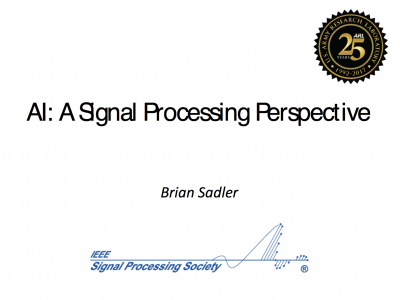Documents
Presentation Slides
AI: A Signal Processing Perspective

- Citation Author(s):
- Submitted by:
- Qiang ZHU
- Last updated:
- 1 December 2017 - 9:19pm
- Document Type:
- Presentation Slides
- Document Year:
- 2017
- Presenters:
- Dr. Brian Sadler
- Categories:
- Log in to post comments
The signal processing (SP) landscape has been enriched by recent advances in artificial intelligence (AI) and machine learning (ML), especially since 2010 or so, yielding new tools for signal estimation, classification, prediction, and manipulation. Layered signal representations, nonlinear function approximation, and nonlinear signal prediction are now feasible at very large scale in both dimensionality and data size. These are leading to significant performance gains in a variety of long standing problem domains (e.g., speech, vision), as well as providing the ability to construct new classes of nonlinear functions (e.g., fusion, nonlinear filtering). In this talk we look at the rapid evolution of signal processing tools and techniques, their strengths and weaknesses, and consider emerging frontiers. From a fundamental SP perspective, open questions include robustness, adaptivity, and performance analysis. Embedding the new techniques into emerging architectures will very likely provide new systems-level solutions for a variety of applications, taking advantage of their strengths while surmounting inherent weaknesses.
Brian M. Sadler is an IEEE Signal Processing Society Distinguished Lecturer for 2017--2018. He is the Senior Scientist for Intelligent Systems at the Army Research Laboratory (ARL) in Adelphi, MD, is a Fellow of ARL, and a Fellow of the IEEE. He has been an associate or guest editor for a variety of journals including the IEEE Transactions on Signal Processing, EURASIP Signal Processing, IEEE SP Letters, IEEE SP Magazine, and the International Journal of Robotics Research. He received Best Paper Awards from the IEEE Signal Processing Society in 2006 and 2010, several ARL and Army R&D awards, and a 2008 Outstanding Invention of the Year Award from the University of Maryland. His research interests include information science, networked and autonomous systems, human-machine teaming, sensing, and mixed-signal integrated circuit architectures, and he has more than 400 publications in these areas with 13,000 citations and h-index of 51.
Please refer to IEEE events LINK below for more information:
https://meetings.vtools.ieee.org/m/47415

